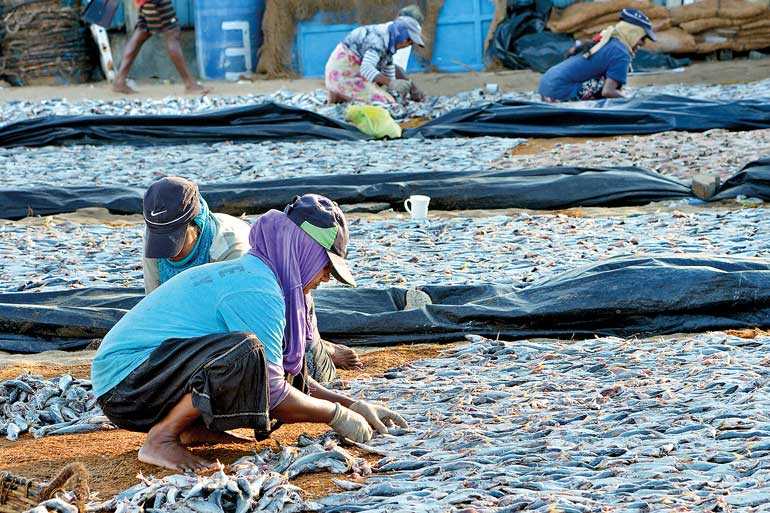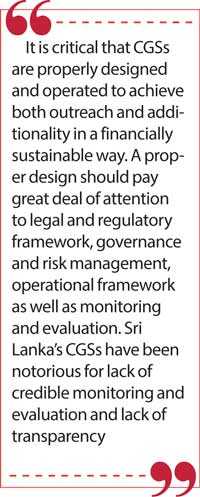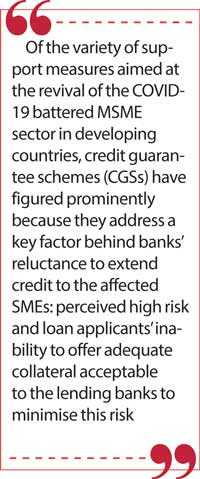Tuesday Dec 02, 2025
Tuesday Dec 02, 2025
Tuesday, 14 July 2020 00:00 - - {{hitsCtrl.values.hits}}

Lack of easy access to formal credit has been a persistent problem for the growth and development of the MSME sector in developing economies
– Pic by Shehan Gunasekara
By Dr. Nimal A. Fernando
According to most policymakers, analysts, academics, sector specialists and other commentators, lack of easy access to formal credit has been a persistent problem for the growth and development of the MSME sector in developing economies. Virtually all demand-side surveys in the sector strongly confirm that this view is widely shared by the enterprise operators across countries as well. Given the fact that a strong and vibrant MSME sector is vital not only for balanced and sustainable economic growth but also for social and political stability, the “credit supply” issue to the sector has gained lots of traction in all developing economies. “Improving the supply of bank credit is undoubtedly one of the major challenges for MSME finance in developing countries, and that fact alone justifies the attention it receives,” a World Bank Policy Research Report that analysed the problem in depth pointed out as far back as 2008.
Finance gap in the MSME sector
As I noted in a recent DailyFT article (http://www.ft.lk/columns/Economic-transformation-of-the-COVID-19-battered-MSME-sector/4-702544), a joint study (2017) by the World Bank, International Finance Corporation and SME Finance Forum put the finance gap for MSMEs in developing and emerging market economies at $ 5.2 trillion. Approximately 56.2 million microenterprises accounted for $ 719 billion (14%) of this gap while 9.0 million SMEs accounted for $ 4.5 trillion (86%). In South Asia the estimated finance gap in the sector was $ 337 billion. Approximately 3.91 million microenterprises accounted for 14% ($ 47 billion) of this gap and about 570,000 SMEs for the remaining $ 290 billion (86%) of the gap. These global and regional numbers are massive. Although it is pertinent to note that according to the study, a relatively larger proportion of both microenterprises and SMEs were not credit constrained both globally and regionally, an acute problem of access to credit exists in the sector for sure. This constraint has been a major factor that limit their growth potential with significant adverse consequences on the overall economy.
This narrative fits in well with Sri Lanka’s situation as well. For example, EY SME Survey 2018 in Sri Lanka revealed that “access to finance is a key constraint faced by over 59% of the respondents” of the survey. The COVID-19 pandemic has further aggravated the problem. A just-completed national study on the impact of COVID-19 pandemic on MSMEs in Sri Lanka stressed that “cash-flow impasse and insufficient working capital are key issues faced” by the affected enterprises. Governments have long recognised the credit problems and introduced a variety of focused policies and programs to address the issue to harness the sector’s potential as much as possible for overall economic growth and development. Again, Sri Lanka is no exception in this regard. This approach has continued into the policy responses to revive the COVID-19 affected MSMEs as well.
Credit guarantees are a widely used instrument
The World Bank’s SME Support Measures Dashboard indicates that out of 845 SME policy instruments used worldwide, 328 (39%) relate to debt finance – loans and guarantees.
Of the variety of support measures aimed at the revival of the COVID-19 battered MSME sector in developing countries, credit guarantee schemes (CGSs) have figured prominently because they address a key factor behind banks’ reluctance to extend credit to the affected SMEs: perceived high risk and loan applicants’ inability to offer adequate collateral acceptable to the lending banks to minimise this risk. A large proportion of MSME assets consists of mobile assets. Banks seek immobile assets as collateral for lending. And banks are reluctant to use higher interest rates to compensate for the perceived higher risk in lending to MSMEs. At the root of these problems are the often-cited, well-known information asymmetry problem. In addition, bank regulations in most countries limit the percentage of the portfolio that banks are permitted to hold as un-secured loans.
Microfinance institutions (MFIs) generally lend without collateral. However, in most countries the MFI sector is not well-developed to fully meet the microenterprises’ demand for credit. And the MFIs themselves face severe constraints in obtaining wholesale funding from banks to meet their liquidity needs to fully serve their clients. Thus, CGSs are relevant for MFIs as well.
Many commentators seem to agree that credit guarantees (CGs) are a better way to address the SME credit issue in Sri Lanka. For example, while analysing the CBSL responses to the COVID-19 pandemic affected businesses, a recent article (https://www.advocata.org/commentary-archives/2020/06/28/blaming-the-banks-why-a-credit-guarantee-is-better) by the Chief Operating Officer of the Advocata Institute noted that, “as the problem is not the lack of money supply, but rather the banks’ reluctance to take risks with regard to loan recovery, a credit guarantee by the Government could have been the first line of solution. That would minimise the risk taken by the banks without adding excess liquidity to the market and distorting other market sentiments.”
Daily FT columnist and former Senior Deputy Governor of the CBSL W.A Wijewardena also recently noted that “…to take the fear of lending out of the mindset of bankers, it is necessary to provide a comprehensive credit guarantee scheme to bankers”(see: http://www.ft.lk/columns/Accelerating-credit-flows-Address-structural-issues-first/4-701937).
The commentators seem to have different views on how to structure and provide it, but there is a clear convergence of views on the need for a CG.
Sri Lanka has been using credit guarantees
The Central Bank of Sri Lanka (CBSL) announced a CG and Interest Subsidy Scheme in last week of June (2020) “to accelerate lending by banks to businesses adversely affected by the COVID-19 pandemic.” The scheme was launched effective 1 July 2020. The CBSL will provide a CG to banks, “ranging from 80 per cent for smaller loans to 50 per cent for relatively larger loans, enabling banks to grant loans to address working capital requirements of the affected businesses.”
The CBSL has been using CGs for a long time for various special credit schemes funded with local resources or with external funding from such organisations as the World Bank, the Asian Development Bank (ADB) and the International Fund for Agricultural Development. For example, the CBSL introduced a partial CGS for cultivation loans in 1967 to support lending by the Bank of Ceylon and the People’s Bank. There is a credit guarantee scheme funded with government resources for short-term loans granted for cultivation of crops by participating financial institutions under the New Comprehensive Rural Credit Scheme as well. In 1979 CBSL introduced a CGS for loans made under the Small and Medium Industries-1 (SMI-I) scheme for which National Development Bank functioned as the apex lender. Similarly, the SMI-II (1982), SMI-III (1987) and SMI-IV (1994) loan projects were also supported through CGs operated by the CBSL.
However, Sri Lanka’s history with CGSs is chequered. A World Bank study in the late 1980s noted that Sri Lankan “commercial banks continued to demand collateral” “even on loans for which guarantees were undertaken … fearing that claims for payment from the guarantee fund would run into bureaucratic problems.” According to the study, banks were dissatisfied with the guarantee scheme. It was disappointing that about 25 years later, in 2015, a study by the Institute of Policy Studies confirmed “the notion that the banking sector is dissatisfied by the CGSs that have been introduced in the past.” But the same study noted that banks unanimously agreed that if properly designed and implemented, CGSs have the “ability to bolster SME access to finance.”
A survey carried out by KPMG in 2016 under a consultancy for the ADB also reconfirmed that financial institutions had negative experiences with the previous CGs. These included, according to the KPMG report, claim processing delays, difficulty to trigger the guarantee, percentage of the guarantee cover and cost of premiums. In most CGSs in the country, rejection of claim applications have been high and frequent due to the non-compliance with the conditions of the guarantees. In addition, cumbersome procedures and poor monitoring and unprofessional approaches used in implementation have also been cited by commentators as negative experience. There is also a dearth of reliable data on implementation of the schemes, and it is not known to what extent corruption has crept into their implementation given that guarantees can open up opportunities for rent-seeking by some connected parties.
In this context, it is critical that CGSs are properly designed and operated to achieve both outreach and additionality in a financially sustainable way. A proper design should pay great deal of attention to legal and regulatory framework, governance and risk management, operational framework as well as monitoring and evaluation. Sri Lanka’s CGSs have been notorious for lack of credible monitoring and evaluation and lack of transparency.
However, proper design and operation is crucial to ensure the prudent and efficient use of public resources used for the CGSs.
Institutional mechanism matters a lot
Sri Lanka’s CG history is littered with negative experiences in part because of the institutional mechanisms used for design and implementation of the schemes. Often they have been introduced as temporary measures in response to, and in association with projects funded partially by, international funding agencies. Plus, political factors and vested interests seem to have often overshadowed sound economic considerations in their design and implementation. The worse appears to be that no concerted effort has been made to seriously address the “credit constraint” in the MSME sector through a CG on an ongoing basis. Thus most CGs have suffered from a discontinuity problem.
KPMG study for the ADB
Addressing these issues requires a sound and efficient institutional structure. The KPMG study (KPMG was engaged by the ADB in 2017 to develop a viable business plan for a proposed credit guarantee institution) considered two institutions with some experience in the field to function as a Credit Guarantee Institution: CBSL and the Sri Lanka Export Credit Insurance Corporation (SLECIC). Both were found to be inappropriate. Although SLECIC has established a relationship with financial institutions, and is accustomed to issuing CGs they are on export-focused loans with
short tenor.
While CBSL has some institutional memory and experience in design and implementation of CGs, it has been noted by the KPMG study, that experience relates to low volume and sector focused schemes. Therefore, the KPMG report concluded that the “CBSL may not have the resource capacity to operate a large scale and complex scheme”.
Considering these factors, among other things, the KPMG study recommended to establish a legally separate Credit Guarantee Institution using the public-private ownership model. And suggested further that “to ensure sustainability and appropriate supervision by CBSL, it should be incorporated as a separate entity as a NBFI (Non-Bank Financial Institution)”.
A report prepared by EY for the German International Corporation (GIZ) office in Sri Lanka in 2018 also recommended establishment of a Credit Guarantee Institution. However, EY report recommended to create this as a CBSL affiliated institution.
Conclusion
Properly designed CGs, if provided through an efficient institutional structure, have the capacity to increase the supply of formal credit to the MSME sector. CGSs have become increasingly popular as they typically combine a public subsidy with market-based credit allocation while addressing an acute structural problem. Credit Guarantee Institutions have been operating successfully in many countries such as Malaysia, South Korea, Japan and Germany, to name a few.
The author of this article is of the view that Sri Lankan policymakers consider setting up a credit guarantee institution with a majority ownership by the CBSL, following the very successful model of the Credit Guarantee Corporation of Malaysia which has helped over 340,000 MSMEs or one-third of the country’s total number of MSMEs since its inception in 1972. Translating this proposal into a reality, however, may require an amendment to the Monetary Law Act because the Monetary Law Act No.58 of 1949 of Sri Lanka, as amended, specifically prohibits the central bank from having a direct interest in any commercial, industrial or other undertaking or to purchase shares of other banking institutions in the normal course of business.
Although the implementation of this proposal would be time consuming, it merits urgent attention when the potential positive impact of a Credit Guarantee Institution on the overall economy is taken into consideration.
A national study on the “Impact of COVID-19 Pandemic on MSMEs in Sri Lanka” has just been completed with a number of sound recommendations. What is more important is to effectively and efficiently implement the recommendations that address structural constraints without sitting on them.
(The writer is a development economist with over 40 years’ experience in the field. He is former Associate of the Kuala Lumpur-based Alliance for Financial Inclusion and former Practice Leader for Microfinance at the Asian Development Bank. He can be reached at [email protected]).